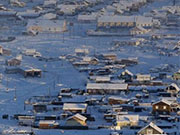

Pluto may be covered in a lot more water ice than astronomers previously thought.
This revelation stems from new data gathered by Nasa’s New Horizons spacecraft, which reveals an abundance of water ice on Pluto’s surface.
The space agency has stitched together images from the observations to create a three-dimensional ‘data cube’ to map the findings.
The two scans were taken 15 minutes apart on July 14, 2015 from 67,000 miles away, showing the hemisphere visible to New Horizons as it flew by. According to Nasa, water ice is the crustal bedrock of Pluto, over the course of the changing seasons, it is covered by more volatile ices
Using observations taken in infrared light by the Ralph/Linear Etalon Imaging Spectral Array (LEISA) instrument, astronomers have created false-colour maps to plot the concentration of Pluto’s water ice.
The two scans were taken 15 minutes apart on July 14, 2015 from 67,000 miles away, showing the hemisphere visible to New Horizons as it flew by.
According to Nasa, water ice is the crustal bedrock of Pluto, and over the course of the changing seasons, it is covered by more volatile ices.
One of these other ices is methane, which can block the ‘spectral signature’ of water ice.
In the first map, shown on the left, the researchers compared LEISA spectra with a pure ice template spectrum to work around this.
But, the map only shows areas that were either very rich in water, or very low in methane.
For the second map, the team used more sensitive techniques, including the various kinds of ice found on the surface, in addition to water ice.
While this method is also limited, Nasa writes, it will be updated continually as more data are collected.
The more detailed map reveals the spread of water ice across much of Pluto, much more than previously known.
Some regions on the map, including Sputnik Planum, the western region of Pluto’s ‘heart,’ and Lowell Regio in the north, were observed to exhibit little evidence of water, if any at all.
This suggests that the bedrock in these areas is buried beneath an accumulation of other ices, such as methane, nitrogen, and carbon monoxide.
Earlier this month, New Horizons sent back one of its most intriguing images of the surface of Pluto. It shows a mysterious object appearing to 'slide' through the surface.
Nasa experts believe the object may be a 'dirty block of water ice'.
Nasa experts believe the object may be a 'dirty block of water ice' which is floating in denser solid nitrogen. Also visible are thousands of pits in the surface, which scientists believe may form by sublimation.
They say it is 'floating' in denser solid nitrogen, and which has been dragged to the edge of a convection cell.
Also visible are thousands of pits in the surface, which scientists believe may form by sublimation.
Transmitted to Earth on Dec. 24, this image from the Long Range Reconnaissance Imager (LORRI) extends New Horizons' highest-resolution views of Pluto to the very center of Sputnik Planum, the informally named icy plain that forms the left side of Pluto's 'heart' feature.
Sputnik Planum is at a lower elevation than most of the surrounding area by a couple of miles, but is not completely flat.
Its surface is separated into cells or polygons 10 to 25 miles (16 to 40 kilometers) wide, and when viewed at low sun angles (with visible shadows), the cells are seen to have slightly raised centers and ridged margins, with about 100 yards (100 meters) of overall height variation.
Mission scientists believe the pattern of the cells stems from the slow thermal convection of the nitrogen-dominated ices that fill Sputnik Planum.
A reservoir that's likely several miles or kilometers deep in some places, the solid nitrogen is warmed at depth by Pluto's modest internal heat, becomes buoyant and rises up in great blobs, and then cools off and sinks again to renew the cycle.
'This part of Pluto is acting like a lava lamp,' said William McKinnon, deputy lead of the New Horizons Geology, Geophysics and Imaging team, from Washington University in St. Louis, 'if you can imagine a lava lamp as wide as, and even deeper than, the Hudson Bay.'
Computer models by the New Horizons team show that these blobs of overturning solid nitrogen can slowly evolve and merge over millions of years. The ridged margins, which mark where cooled nitrogen ice sinks back down, can be pinched off and abandoned.
The 'X' feature is likely one of these—a former quadruple junction where four convection cells meet. Numerous, active triple junctions can be seen elsewhere in the LORRI mosaic.
 |
Day|Week

 'Coldest town in China' — a fairyland you don't want to miss
'Coldest town in China' — a fairyland you don't want to miss Deep love for breathtaking Hainan
Deep love for breathtaking Hainan Beautiful Chinese tennis player Wang Qiang goes viral online
Beautiful Chinese tennis player Wang Qiang goes viral online Minus 71 degrees! Coldest village on earth
Minus 71 degrees! Coldest village on earth Chinese pole dancing master opens class in Tianjin
Chinese pole dancing master opens class in Tianjin The most beautiful town of snow in China
The most beautiful town of snow in China SWAT members hold romantic wedding in E China
SWAT members hold romantic wedding in E China Breathtaking scenery and simple lifestyle in Hainan
Breathtaking scenery and simple lifestyle in Hainan Finding sexiest underwear supermodels
Finding sexiest underwear supermodels Top 10 ancient pagodas in China
Top 10 ancient pagodas in China